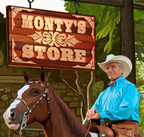I have an almost 5 mo old rescue filly who is generally quite confident. She is not a 'spooky' horse. We work with her every day. She has seen the farrier and the vet once. The vet visit went fine, even though she received shots, microchip, etc. The farrier, however, 'jingles and carries a strange-looking object'. She is due for a trim in the coming weeks. My question is, is it best to bring your horse toward a "scary thing" or bring the scary thing to them? Or does it even matter? Size being a factor, of course.
Rewards
Subscribe to Equus Online University and become a part of Monty's worldwide mission to leave the world a better place for horses and for people too.
Students automatically gain access to special rewards, such as exclusive discounts at the Monty Roberts Online Shop. Visit Monty Roberts Online Shop.




I use both ways. If you look at the plastic bag on a stick work that monty does, he takes the bag to the horse, stays with it until the horse is still them moves the stick away giving the horse relief - the horse 'teaches' the stick to go away "Advance and Retreat"
:
With big or jingly or flappy objects, (like a tractor or a feedbag lying aorund!) I might go up to the tractor (or whatever) myself with the horse on a loose line staying away from it (watching the horse carefully of course!) touch the tractor myself and come away a few times. Often the horse will realise that there is nothing to worry about if he trusts my judgement and his natural curiosity means he may come forward and investigate. At the point it is really important to stay alert but very calm and to have great patience while he does his own "advance/retreat" so the horse has a choice and can move away again if he wants to. You must be patient with this bit and not try to rush things. This does not work if a horse is already terrified of something through bad experience - this is more for new unknown objects "Does it go in my safe or scary box".
:
Foals/youngsters usually come into the unknown/curiosity bracket but great care must be taken as it is much harder to move something from the "scary box" to the "safe box" that it is to move it from the "Unknown box" to the "Safe box"! Use this curiosity to your advantage. Put the jingly thing somewhere that he can have a look at it and know that it can't hurt him.
:
Strange looking objects that need to be used on the horse (e.g.rasp) need to be brought to the horse as it is not something he can look at, touch, and then say "Oh it's ok" and never have to deal with it again; it's something he has to get used to feeling and having interact with him. For this I would use the advance and retreat just like the plastic bag on a stick work that Monty does.
:
Good luck, let us know how you get on.
Hi. I have a colt & a filly foal, home bred. Kirk was born in a livery yard, everybody visited him regularly & he was handled from day one. I now have a confident, cheeky yearling who loves people & attention & is desperate to learn anything new or investigate new situations. The filly was born in the field at home & she is so different from her brother. Not cheeky but confident but in a different way. Moley has her own ideas & is more like her Mother who was ever vigilant. Whereas Kirk took to everything first time, Moley likes time to assess the situation. Every horse is an individual & to meet their needs requires us to be flexible & patient, especially when they are juvenile. I'm not saying let them dominate but let their reactions govern your responses. Take more slow steps when they find things harder. Be their guide, calm & gentle, not their oppressors. Your patience will be rewarded in the long run. Consistency is key. Repeating successful advances builds confidence in you both. The ability to change how a task is requested when there is misunderstanding & fear will build a massive bond between you. Good luck & keep us updated on your progress. Cheers, Jo.
To add to what Vicci has said. Get out a grooming box. Pull out anything and everything. First let the horse see the object. Use the Advance and Retreat method. Then let the horse smell the objects. Again, Advance and Retreat. Then introduce the object to all parts of the horse body including it's hooves. All through Advance and Retreat. I would also add, spry bottles of fly repellent and/or antiseptics as well as a used wormier syringe and empty pop cans. Find anything you can laying around that a horse will encounter that people use for the care and maintenance of horses. This will go a long way to desensitizing them to new things the are noise, jingle around or are flashy.